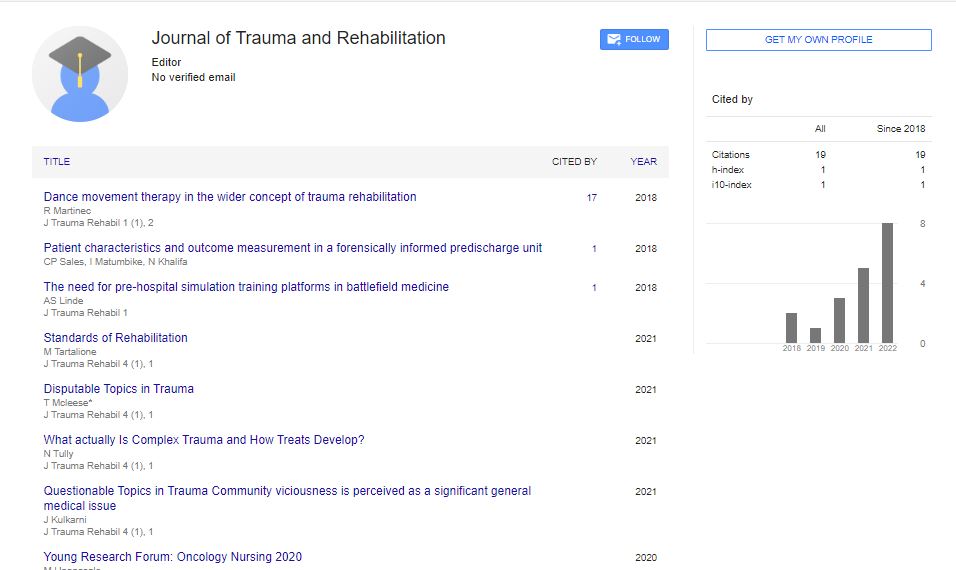Perspective, J Trauma Rehabil Vol: 6 Issue: 4
Comprehending the Diverse Aspects of Spinal Trauma
Camlar Schultz*
1Department of Trauma and Emergency Surgery, University of Arizona, Arizona, United States of America
*Corresponding Author: Camlar Schultz,
Department of Trauma and Emergency
Surgery, University of Arizona, Arizona, United States of America
E-mail: camlaschul@surgery.arizona.edu
Received date: 24 November, 2023, Manuscript No. JTR-24-127959;
Editor assigned date: 27 November, 2023, PreQC No. JTR-24-127959 (PQ);
Reviewed date: 11 December, 2023, QC No. JTR-24-127959;
Revised date: 18 December, 2023, Manuscript No. JTR-24-127959 (R);
Published date: 26 December, 2023, DOI: 10.4172/Jtr.1000143
Citation: Schultz C (2023) Comprehending the Diverse Aspects of Spinal Trauma. J Trauma Rehabil 6:4.
Description
Spinal trauma, characterized by injuries to the delicate spinal cord, is a complex and often life-altering event that can result in a spectrum of consequences. Understanding the diverse aspects of spinal trauma encompasses exploring its complex manifestations, ranging from immediate physical effects to long-term consequences on an individual's overall well-being. At the forefront of comprehending spinal trauma is the recognition of its immediate impact on neurological function. The spinal cord, a vital component of the central nervous system, serves as a conduit for transmitting signals between the brain and the rest of the body. When trauma occurs, the disruption of these neural pathways can lead to paralysis or impaired sensory and motor function below the injury site. The severity and extent of these neurological deficits are influenced by factors such as the level and type of injury, as well as individual variations in physiology.
The immediate physical consequences of spinal trauma extend beyond neurological impairment. Individuals may experience musculoskeletal issues, such as loss of muscle tone, changes in posture and alterations in bone density. The abrupt interruption of neural signals to the autonomic nervous system can result in complications such as blood pressure instability, respiratory challenges and disruptions in bladder and bowel function. The immediate aftermath of spinal trauma necessitates prompt medical attention and interventions to address these acute physiological challenges. However, the impact of spinal trauma reaches far beyond the physical realm. Psychosocial dimensions play a vital role in shaping the overall experience of individuals dealing with spinal cord injuries. Emotional responses, such as grief, anxiety and depression, are common reactions to the profound changes in one's life that often accompany spinal trauma. The adjustment to a new reality, marked by altered abilities and potential lifestyle changes, requires comprehensive psychological support.
The process of understanding spinal trauma also involves an exploration of the long-term consequences that individuals may face. Chronic pain is a prevalent and persistent issue for many with spinal cord injuries, resulting from nerve damage, altered sensory perception and musculoskeletal strain. Managing chronic pain becomes an integral aspect of post-trauma care, often requiring a combination of pharmacological, rehabilitative and psychological interventions. In addition to physical and emotional challenges, individuals with spinal cord injuries navigate social and vocational adjustments. Stigma and misconceptions surrounding disability may contribute to societal barriers, limiting opportunities for employment, education and community participation. Overcoming these societal hurdles requires advocacy, awareness and the promotion of inclusivity to ensure individuals with spinal trauma can lead fulfilling and meaningful lives.
Advancements in medical and rehabilitative interventions have significantly contributed to enhancing the quality of life for those affected by spinal trauma. Innovative technologies, such as assistive devices, exoskeletons and neuroprosthetics, aim to restore mobility and independence. Physical therapy and rehabilitation programs customized to individual needs play a pivotal role in maximizing functional abilities and promoting overall well-being. The landscape of spinal trauma analysis is marked by ongoing efforts to reveal the complexities of neural regeneration and repair. Regenerative medicine and neurostimulation therapies have potential for promoting recovery by customizing the damaged neural tissue.
Conclusion
A comprehensive understanding of spinal trauma also involves recognizing the importance of a multidisciplinary approach to care. Teams of healthcare professionals, including neurologists, orthopedic surgeons, physical therapists, psychologists and social workers, collaborate to address the diverse needs of individuals with spinal cord injuries. This comprehensive approach acknowledges that effective care extends beyond the immediate medical concerns to encompass the broader spectrum of physical, emotional and social dimensions. Comprehending the diverse aspects of spinal trauma is a nuanced exploration of its immediate and long-term consequences. From the immediate neurological impact to the chronic challenges of managing pain and navigating societal barriers, individuals with spinal trauma embark on a multidimensional expedition.
 Spanish
Spanish  Chinese
Chinese  Russian
Russian  German
German  French
French  Japanese
Japanese  Portuguese
Portuguese  Hindi
Hindi 